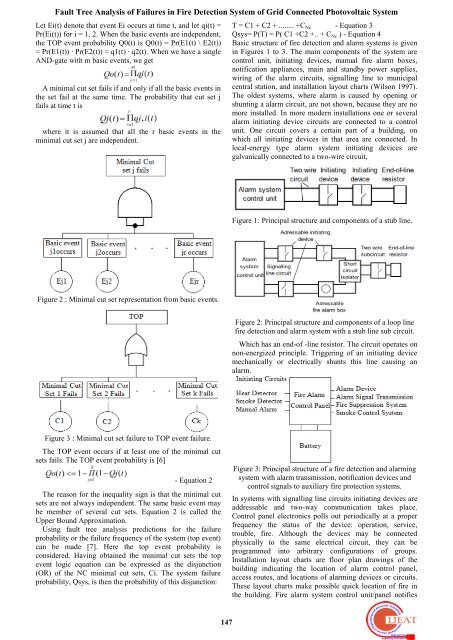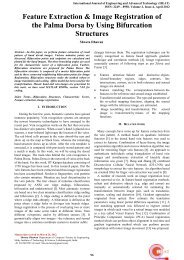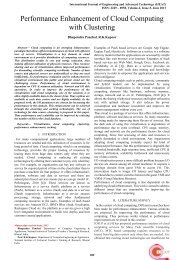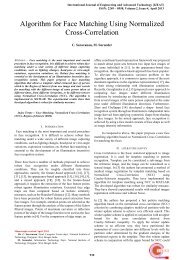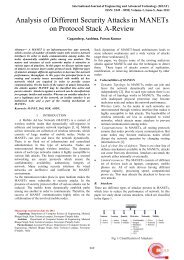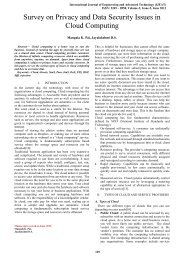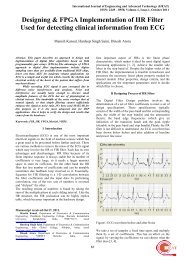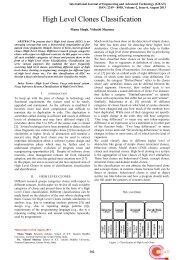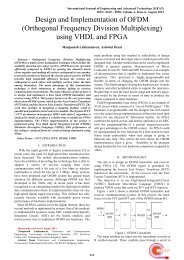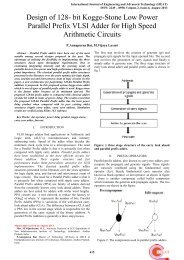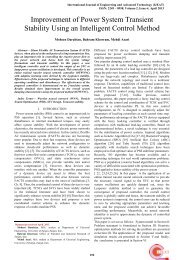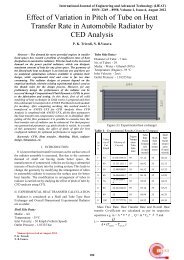Fault Tree Analysis of Failures in Fire Detection System of Grid ...
Fault Tree Analysis of Failures in Fire Detection System of Grid ...
Fault Tree Analysis of Failures in Fire Detection System of Grid ...
Create successful ePaper yourself
Turn your PDF publications into a flip-book with our unique Google optimized e-Paper software.
<strong>Fault</strong> <strong>Tree</strong> <strong>Analysis</strong> <strong>of</strong> <strong>Failures</strong> <strong>in</strong> <strong>Fire</strong> <strong>Detection</strong> <strong>System</strong> <strong>of</strong> <strong>Grid</strong> Connected Photovoltaic <strong>System</strong>Let Ei(t) denote that event Ei occurs at time t, and let qi(t) =Pr(Ei(t)) for i = 1, 2. When the basic events are <strong>in</strong>dependent,the TOP event probability Q0(t) is Q0(t) = Pr(E1(t) \ E2(t))= Pr(E1(t)) · Pr(E2(t)) = q1(t) · q2(t). When we have a s<strong>in</strong>gleAND-gate with m basic events, we getA m<strong>in</strong>imal cut set fails if and only if all the basic events <strong>in</strong>the set fail at the same time. The probability that cut set jfails at time t iswhere it is assumed that all the r basic events <strong>in</strong> them<strong>in</strong>imal cut set j are <strong>in</strong>dependent.T = C1 + C2 + ........ +C Nc - Equation 3Qsys= P(T) = P( C1 +C2 +.. + C Nc ) - Equation 4Basic structure <strong>of</strong> fire detection and alarm systems is given<strong>in</strong> Figures 1 to 3. The ma<strong>in</strong> components <strong>of</strong> the system arecontrol unit, <strong>in</strong>itiat<strong>in</strong>g devices, manual fire alarm boxes,notification appliances, ma<strong>in</strong> and standby power supplies,wir<strong>in</strong>g <strong>of</strong> the alarm circuits, signall<strong>in</strong>g l<strong>in</strong>e to municipalcentral station, and <strong>in</strong>stallation layout charts (Wilson 1997).The oldest systems, where alarm is caused by open<strong>in</strong>g orshunt<strong>in</strong>g a alarm circuit, are not shown, because they are nomore <strong>in</strong>stalled. In more modern <strong>in</strong>stallations one or severalalarm <strong>in</strong>itiat<strong>in</strong>g device circuits are connected to a controlunit. One circuit covers a certa<strong>in</strong> part <strong>of</strong> a build<strong>in</strong>g, onwhich all <strong>in</strong>itiat<strong>in</strong>g devices <strong>in</strong> that area are connected. Inlocal-energy type alarm system <strong>in</strong>itiat<strong>in</strong>g devices aregalvanically connected to a two-wire circuit,Figure 1: Pr<strong>in</strong>cipal structure and components <strong>of</strong> a stub l<strong>in</strong>e.Figure 2 : M<strong>in</strong>imal cut set representation from basic events.Figure 2: Pr<strong>in</strong>cipal structure and components <strong>of</strong> a loop l<strong>in</strong>efire detection and alarm system with a stub l<strong>in</strong>e sub circuit.Which has an end-<strong>of</strong> -l<strong>in</strong>e resistor. The circuit operates onnon-energized pr<strong>in</strong>ciple. Trigger<strong>in</strong>g <strong>of</strong> an <strong>in</strong>itiat<strong>in</strong>g devicemechanically or electrically shunts this l<strong>in</strong>e caus<strong>in</strong>g analarm.Figure 3 : M<strong>in</strong>imal cut set failure to TOP event failure.The TOP event occurs if at least one <strong>of</strong> the m<strong>in</strong>imal cutsets fails. The TOP event probability is [6]- Equation 2The reason for the <strong>in</strong>equality sign is that the m<strong>in</strong>imal cutsets are not always <strong>in</strong>dependent. The same basic event maybe member <strong>of</strong> several cut sets. Equation 2 is called theUpper Bound Approximation.Us<strong>in</strong>g fault tree analysis predictions for the failureprobability or the failure frequency <strong>of</strong> the system (top event)can be made [7]. Here the top event probability isconsidered. Hav<strong>in</strong>g obta<strong>in</strong>ed the m<strong>in</strong>imal cut sets the topevent logic equation can be expressed as the disjunction(OR) <strong>of</strong> the NC m<strong>in</strong>imal cut sets, Ci. The system failureprobability, Qsys, is then the probability <strong>of</strong> this disjunction:Figure 3: Pr<strong>in</strong>cipal structure <strong>of</strong> a fire detection and alarm<strong>in</strong>gsystem with alarm transmission, notification devices andcontrol signals to auxiliary fire protection systems.In systems with signall<strong>in</strong>g l<strong>in</strong>e circuits <strong>in</strong>itiat<strong>in</strong>g devices areaddressable and two-way communication takes place.Control panel electronics polls out periodically at a properfrequency the status <strong>of</strong> the device: operation, service,trouble, fire. Although the devices may be connectedphysically to the same electrical circuit, they can beprogrammed <strong>in</strong>to arbitrary configurations <strong>of</strong> groups.Installation layout charts are floor plan draw<strong>in</strong>gs <strong>of</strong> thebuild<strong>in</strong>g <strong>in</strong>dicat<strong>in</strong>g the location <strong>of</strong> alarm control panel,access routes, and locations <strong>of</strong> alarm<strong>in</strong>g devices or circuits.These layout charts make possible quick location <strong>of</strong> fire <strong>in</strong>the build<strong>in</strong>g. <strong>Fire</strong> alarm system control unit/panel notifies147


